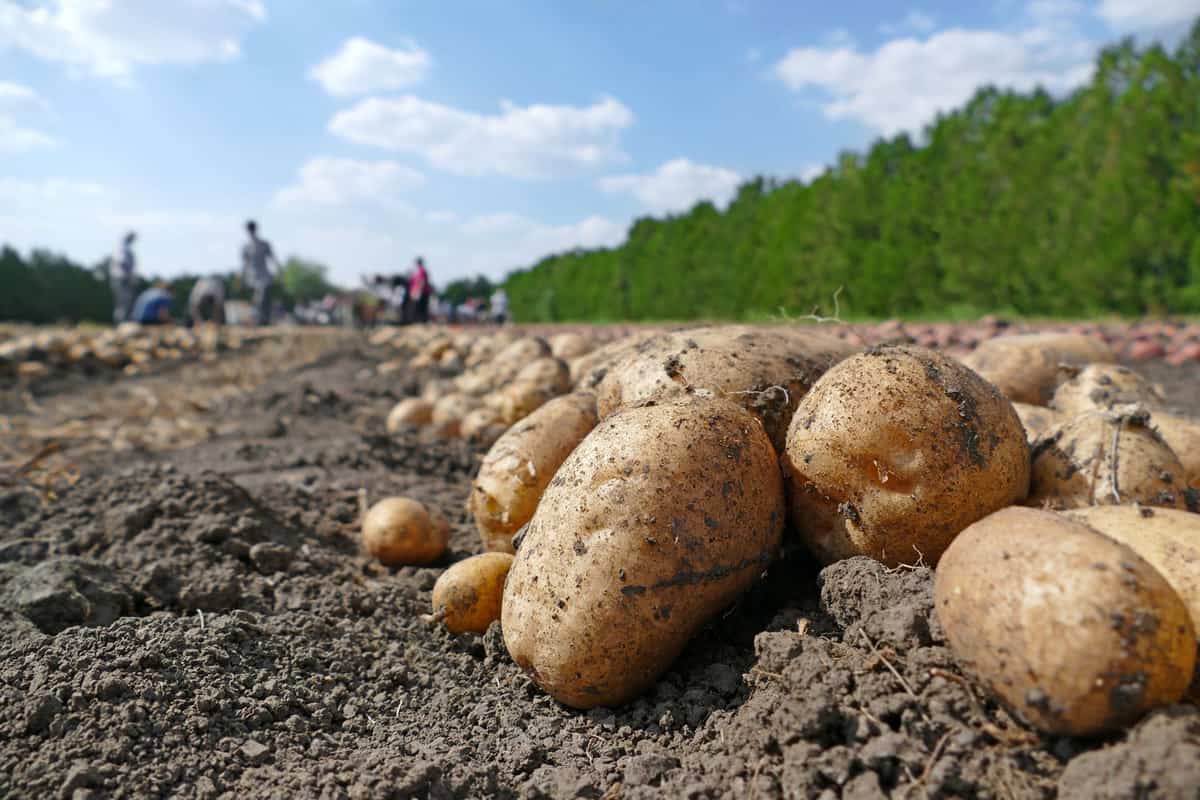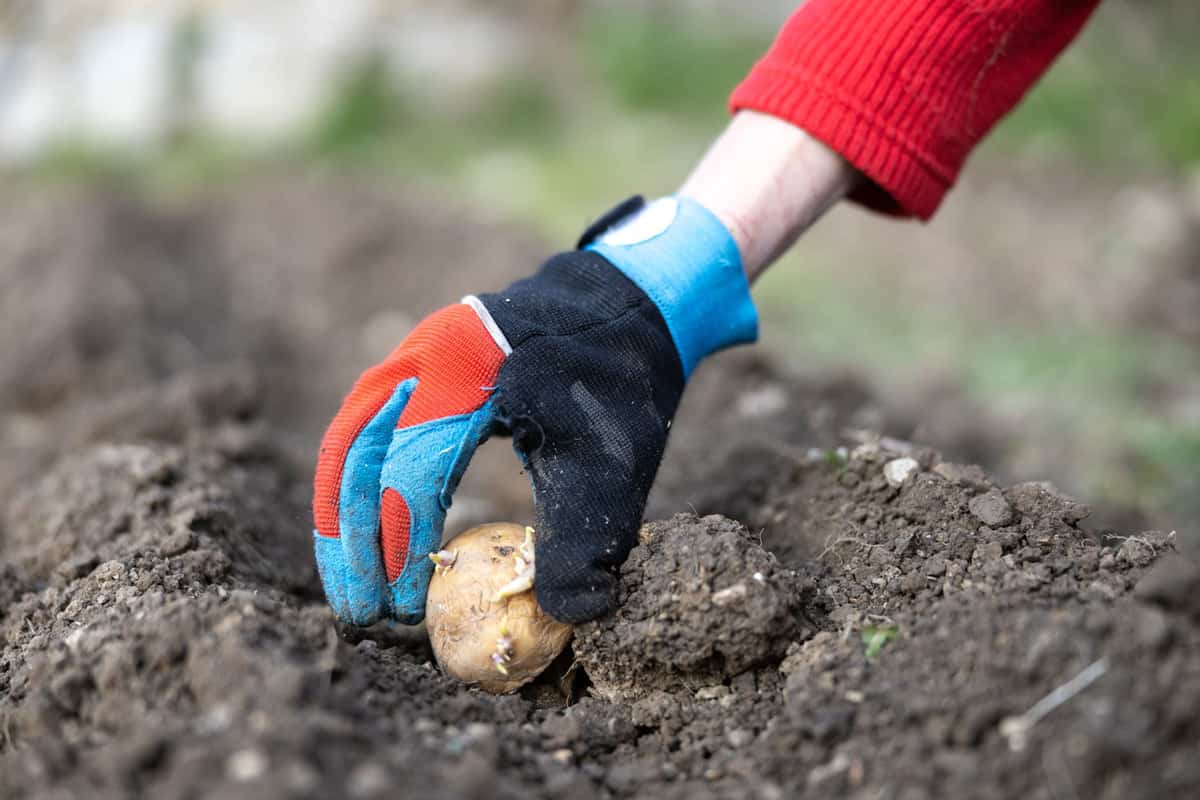Potatoes are a relatively easy plant to grow, especially if you live in a warm and sunny area. Because of their size and the fact that they're a root vegetable, it's important to consider the depth they're planted to ensure that they get the nutrients they need to thrive. But how deep should they be planted? We've researched the best depth to plant potatoes, and in this post, we will answer this question for you.
Potato plants grow best when they're planted at least 6 to 8 inches beneath their soil. Though these plants are low maintenance, planting them at the correct depth can make the difference between plants that grow to be healthy and large and those plants whose growth become stunted from malnourishment. It's also essential to place the potato plants at least 12 to 15 inches apart from one another to have sufficient room to breathe as they mature.

Are you new to planting potatoes? Unsure how to care for them once they're in the ground? If so, keep reading to learn more about how to plant and tend to these crops.
Potato Planting Depth

While they are in their early growth stages, potato plants need to be completely covered with soil to receive nourishment. It's important for the soil in which they are grown to be loose and well-aerated. Compact soil can make it hard for the potato plants to receive water and nutrients through their roots adequately.
It also makes the plant extremely difficult to harvest once they're ready. If you plant the plant in a shallow trench, keep in mind that you can always add soil and mulch as needed, however. Also, if you have seed potatoes, you can plant the trenches as shallow as 4 to 6 inches deep to help them grow faster. These plants should be about 8 to 12 inches apart, however.
As the plants grow, it's best to mound the surrounding hill around them until the plant is covered. But what is mounding? And how do you do it? Let's discuss.
Hilling Potatoes
One of the most important things to stay on top of when growing potatoes at home is the health of their tubers. Potato tubers can become dry and eventually die from receiving too much sunlight for too long. They can also turn a greenish hue and start to produce solanine. Solanine is a toxic compound that makes the potatoes very bitter and inedible. To prevent this, growers will typically hill (aka "mound") the potatoes at least 3 to 4 times during the growing season.
Hilling potatoes involves pulling up the surrounding soil at the base of the plant stem and bringing it up to cover the plant adequately. This is usually done in the morning before the sun rises to prevent the plants from being exposed to direct sunlight during the day. This way, the new tubers are protected from the sunlight and can create more tubers before the harvest.
The best time to hill potato plants is approximately three weeks from when they are planted. A good sign to determine when they are ready to be filled is when the baby sprouts begin pushing up through the soil. Once you notice this, be sure to hill the loose dirt around the plants and any compost, straw, leaves, and mulch. Make sure that the sprouts are completely covered. The next time the plant should be hilled is when it grows an additional 6 to 8 inches taller.
Watering Potato Plants
Sometimes the potato plants may need additional water right after they have been mounded. One quick way to determine if this is required is by grabbing a handful of soil to determine its moisture level. The soil should feel slightly damp and loose. If it is dry, be sure to water it as needed. If it feels too wet, give it is a few days to drain before watering again.
If a potato plants' soil is overwatered, the plants will be susceptible to various diseases. It's always best to water potato plants in the morning so that they can have time to dry out during the day while exposed to sunlight. This prevents them from over-drying.
Weeding Potato Plants
Weeding your potato plant is another essential step to producing a full harvest. Removing weeds helps preserve the water and nutrients strictly for the potato plants, as weeds can easily suck the nourishments from the plant. It's essential to have a reliable hoe when cultivating the area around the plants to keep them free of nutrient-sucking weeds and plants.
Learn more about this garden hoe on ;k.
What month do you plant potatoes?
Potato plants prefer cooler weather to grow. The best time to plant them is around mid-April or five to seven weeks before the last frost date. Potato plants prefer soil temperatures of anywhere from 45 to 55 degrees Fahrenheit. This is especially important for baby potato plants if they are more vulnerable to plant disease and environmental factors.
Be sure to check the temperature of the soil before planting your potatoes to ensure that all of the frost is gone. Though the plants can handle a bit of light frost, heavy layers of frost within the soil will surely damage them very quickly.
Learn more about this garden thermometer on Amazon.
Do you need to cut seed potatoes before planting?

It depends on the size of the seed. If the seed potato is anywhere from 11/2 to 2 ounces, you don't need to cut it. However, if the seed is over a couple of ounces, you'll need to cut it into smaller pieces. The goal is to have at least two eyes on the seed. However, one will suffice as well.
When cutting the potato, it doesn't matter which way you cut it, but avoid cutting the eyes if possible. Also, be sure that the knife you use to cut your potatoes is sharp and clean. It helps to douce it in alcohol to avoid transferring any bacteria or dirt from other plants to the potatoes.
Check out this garden knife on Amazon.
Do you plant seed potatoes with eyes up or down?
It's best to plant seed potatoes with the eyes facing up. You'll usually find that seed potatoes will have at least one eye. If the seed potatoes have two, try to plant them so that either of them or the largest one faces up.
Can you plant potatoes too deep?
It's not best to do this. Why? Because potato plants need enough room for reproduction. Planting them too deeply can cause the plants to rot before they have a chance to sprout. Also, it makes harvesting the plant very difficult during the end of the season because the root vegetable is buried so deeply into the soil. This can make for a physically exhausting harvesting session.
Instead of planting potatoes too deeply, gardeners use mounding to keep the plants covered in soil and accessible for water and nutrients. You can even mound the potatoes every 3 to 4 weeks if needed. If you don't have a hoe, you can also use a small shovel to quickly dig up the dirt around the stems and cover the plants on top. Be sure that at least some of the plant is visible so that it'll keep growing.
How many potatoes will grow from one potato?
On average, a single potato plant can produce a minimum of 3 to 4 pounds of potatoes. Seed potatoes, however, can produce about 4-6 potato plants.
What's the difference between seed potatoes and regular potatoes?

Seed potatoes are potatoes that have been drawn and replanted to produce a new crop. This is how most potatoes are made available to growers and farmers.
One of the benefits of growing sweet potatoes is that they are disease and virus-free. They are typically made from different microtubules and microfilaments, and many are produced in labs to ensure their quality.
Technically seeds are actually tubers. The tubers will be genetically identical to their parent plant, and they are typically only grown a limited number of times to ensure vigor. For example, if you save your own seed potatoes and use them more than a few times, you'll find that subsequent Harvest may not be as successful as the initial plants-- especially if you go so far as sixth and seventh-generation plants.
"Regular potatoes" are generally considered store-bought potatoes. These potatoes are grown for consumption as opposed to planting. And can though they're inspected for diseases, as most crops are, they aren't put through the same testing as seed potatoes. Regular potatoes are usually grown in the ground as opposed to microtubules.
Can I grow potatoes from store-bought potatoes?
Yes. You can and grow potatoes from store-bought potatoes. If the potatoes are starting to sprout, you can plant them in the ground to grow new potato plants.
Wrapping Things Up

The depth at which you plant potatoes makes a considerable difference in their ability to grow fully and offer a complete harvest. Always be sure that your trenches are at least 7 inches in the ground and spaced at least 12 inches apart so that they don't make contact with adjacent plants as they grow.
Before you go, be sure to check out our other posts:



